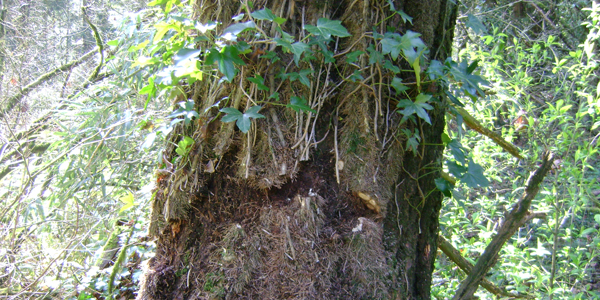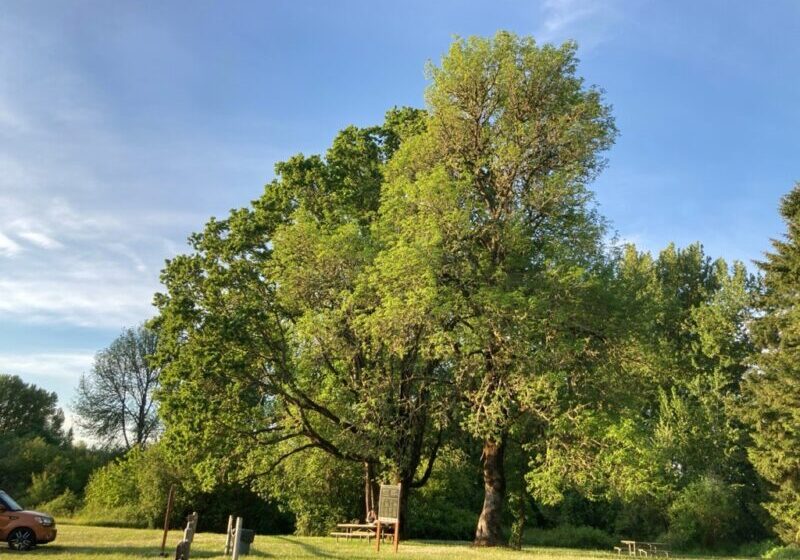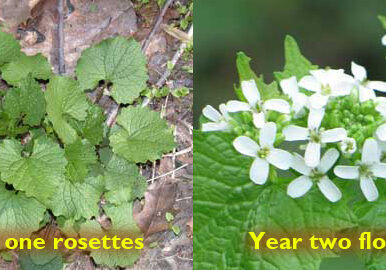(Photo: Ivy vines cut from a tree.)
Spring inevitably brings on the urge to get outside and work the land. Our forest and habitat restoration work often encompasses invasive species control, planting of native trees and shrubs, and control of any competing vegetation that might threaten our desired plants. This spring, we encourage you to get outside and here are some tips for making your projects a success.
Invasive weeds and competing vegetation
You may encounter invasive weeds recurring in your planting areas, or invading new areas of your property. The first step is to identify them and then determine the best time of year to tackle what you have.
- Spring is an ideal time to treat many weeds and grasses before they go to seed and disperse into other areas. Controlling grasses around new plantings at this time of year allows the spring rains to benefit the new plants rather than weeds and competing plants.
- Don’t apply herbicides if the weather is cold. Temperatures should be above 45F and ideally the temperature would get above 50F later in the day. A hard frost is not conducive to herbicide uptake, nor the consistency of herbicide in the tank.
- Always follow the guidelines and restrictions on herbicide labels and wear personal protective equipment.
- If you find any new weeds that you cannot identify, please contact the Multnomah County Master Gardeners.
- In the spring, we have less fire risk than in the summer. However, it is still a good idea to check Oregon Dept. of Forestry regulations before beginning work.
- Birds are beginning to nest, and you should be careful when performing any vegetation management during the spring and early summer. We are currently in the early nesting season (Feb 1 – April 15). Late nesting season is from April 15-July 31 and disturbance should be avoided if possible, with steps taken to minimize impacts when appropriate. Find more guidance on protecting nesting birds at portlandoregon.gov/bes/article/322164.
Grasses and forbs: Grasses and various weeds can steal moisture from your newly planted trees and shrubs. You can control this competition by hand pulling, mowing or cutting. Adding mulch or wood chips can help as well. Another option is herbicide treatment within about 3’ of each plant. Different herbicides are formulated for various kinds of vegetation. Contact us for guidance on herbicide selection and best practices.
High priority weeds – Garlic Mustard, spurge laurel, and other weeds that are new to our region:
Certain weeds are a very high priority to control because of the rate at which they can spread or their toxicity to people or other native plants (or other reasons). Contact us if you have Garlic mustard, spurge laurel, Giant hogweed, Japanese knotweed, Orange hawkweed, American pokeweed, or False brome. We can help control many of these weeds at no cost to you, and we want to know where these weeds are growing.
Himalayan (Armenian) & Cutleaf (Evergreen) Blackberries: Although fall is often the best time to control invasive blackberry, there is some work you can do in the spring as well.
- Dig up small patches when soil is moist and easier to work, particularly in areas where digging won’t lead to erosion or jeopardize slope stability. Once the main rootwad has been extracted, the blackberry cane should not return.
- For larger patches, following a fall cutting, herbicide is an option for treating new spring growth. If you wait until the fall to treat this growth, you’ll undo much of the benefit of the cutting. Contact us for guidance on herbicide selection and best practices. Utilize only aquatic formulations when spraying near waterways. Plan to treat when no rain is forecast for at least 24 hours.
Scotch broom: This can be treated similarly to blackberry. Don’t mow it in the spring or it will sprout vigorously and you might stir up the seed bed. Disturbance can lead to a great deal of new growth from seed.
English & Irish Ivy: Focus efforts on vines that are climbing up trees to prevent the spread of mature fruits which typically only form when the vines reach sunlight. Sever vines from the roots by carefully cutting an 18” section out of each vine at about chest height. Pull back the rooted vines to at least 6’ from the base of the tree, uprooting them if possible, to create a “life saver” ring around each tree. For more ivy removal techniques, see this Best Management Practice Guide. Alternatively, apply 50% triclopyr, (e.g. Garlon 3a or Vastlan), or 50% glyphosate immediately to the freshly cut rooted vine.
Shiny Geranium and herb-robert: These two plants are actively growing right now. Keep an eye out for new patches and handpull small areas. Large infestations can be treated in the spring before flowering.
Thistle, teasel, poison hemlock, and tansy ragwort: Every spring and summer we get questions about these weeds and they could be encroaching on your property, especially in cleared areas. In general, a 1-2% mix of triclopyr can work well on these weeds before they flower, or just as they’re beginning to flower. This timing is also good if you’re planning to cut the weeds rather than use herbicides.
Tree cutting
If you have hazard trees that may be at risk of damaging property, falling into a road, or hurting desirable vegetation, I recommend that you deal with these as soon as you identify the risk and can remove them safely. Often times this means hiring a trained arborist to assess the risk or remove the trees.
Otherwise, I would encourage you to focus on tree cutting in the fall. Two main reasons for this:
- Many species including Douglas-fir are more sensitive and more prone to damage in the spring while they are actively growing. Summer can be too hot and risky for tree cutting. Oregon Department of Forestry or your local rural fire department may have restrictions on using power driven machinery during this time when wildfire risk is high.
- Much of the tree cutting occurring in the West Hills is restoration based. This can often mean that a landowner is cutting hardwoods to provide space for conifers. It is best to cut trees in fall when they are less likely to sprout from the stump and surrounding roots.
But wait, a logger just told me that we should do our logging job in the summer?!?! Smaller scale tree cutting described above is best for fall, however if you’re hauling logs away, summer can be a good time. In the Tualatin Mountains, we often don’t have adequate forest roads for log trucks to perform winter hauling, so we have to work in the summer when the ground is dry.
Caring for New Native Tree and Shrub Plantings
If you’ve recently planted new trees and shrubs, watering can be very helpful. If you can get a hose or a sprinkler to a planting, go for it. You only need to do this a few times over the summer when temperatures have become hot and we’re not getting rainfall. When you water, give the plants a thorough dousing where the ground around the plants is visibly wet. If you aren’t able to water don’t worry too much. Many of our restoration sites with native plantings are not near a water source.
In all situations, weed control around new plants is very important, even if you’re able to water. The watering is helpful for the first couple years, and then you should back off and let the plants grow on their own so they can establish root systems that are adapted to the natural moisture available on site.



